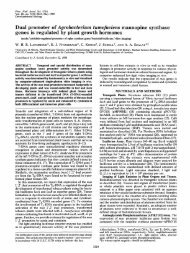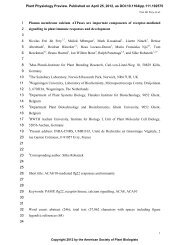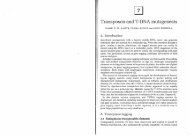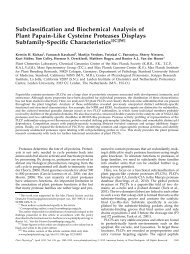A Conserved Domain of the Arabidopsis GNOM ... - The Plant Cell
A Conserved Domain of the Arabidopsis GNOM ... - The Plant Cell
A Conserved Domain of the Arabidopsis GNOM ... - The Plant Cell
You also want an ePaper? Increase the reach of your titles
YUMPU automatically turns print PDFs into web optimized ePapers that Google loves.
344 <strong>The</strong> <strong>Plant</strong> <strong>Cell</strong><br />
protein Hsp90–dependent signal transduction in glucocorticoid<br />
receptor regulation (Mattila et al., 1990; Bram and<br />
Crabtree, 1994; Duina et al., 1996).<br />
Only a few studies have addressed <strong>the</strong> role <strong>of</strong> Cyp proteins<br />
during dimerization or oligomerization <strong>of</strong> target molecules.<br />
In <strong>the</strong> mouse glucocorticoid receptor complex, for<br />
example, Cyp40 interacts with <strong>the</strong> dimerization domain <strong>of</strong><br />
Hsp90 (Carrello et al., 1999), and a yeast Cyp40 homolog,<br />
Cpr6, can reactivate <strong>the</strong> ATPase activity <strong>of</strong> Hsp90 in vitro<br />
(Prodromou et al., 1999). As an example <strong>of</strong> Cyp interaction<br />
with an oligomeric target in vivo, human CypA was shown to<br />
bind to <strong>the</strong> human immunodeficiency virus HIV-1 capsid<br />
protein Gag (Luban et al., 1993; Franke et al., 1994). Mutations<br />
in Gag abolish both CypA incorporation into virions<br />
and virion infectivity, mimicking <strong>the</strong> effects <strong>of</strong> cyclosporin A<br />
treatment <strong>of</strong> infected cells (Franke et al., 1994).<br />
Our study identifies a conserved protein domain <strong>of</strong> a large<br />
ARF GEF that mediates both subunit interaction and Cyp<br />
binding. <strong>GNOM</strong>-interacting Cyp5 is a cyclosporin A–sensitive<br />
peptidylprolyl cis/trans–isomerase (PPIase) with protein refolding<br />
activity that is also expressed during embryogenesis.<br />
We propose that Cyp5 is a potential regulator <strong>of</strong> <strong>GNOM</strong><br />
function in <strong>Arabidopsis</strong> embryogenesis.<br />
RESULTS<br />
Interaction <strong>of</strong> <strong>GNOM</strong> Subunits Mediated by an<br />
N-Terminal <strong>Domain</strong><br />
Genetic complementation between different gnom mutant<br />
alleles suggested that <strong>GNOM</strong> function involves physical interaction<br />
<strong>of</strong> <strong>GNOM</strong> subunits (Mayer et al., 1993; Busch et<br />
al., 1996). To examine this model, we generated a series <strong>of</strong><br />
<strong>GNOM</strong> deletion constructs in interaction trap vectors <strong>of</strong> <strong>the</strong><br />
yeast two-hybrid system (Gyuris et al., 1993). As shown in<br />
Figures 1A and 1B, interaction was observed between<br />
nearly full-length <strong>GNOM</strong> proteins lacking <strong>the</strong> first 17 amino<br />
acids. <strong>The</strong> region required for self-interaction was mapped<br />
to <strong>GNOM</strong> amino acids 1 to 246 (<strong>GNOM</strong> 1–246 ) encoded by <strong>the</strong><br />
first exon <strong>of</strong> <strong>the</strong> <strong>GNOM</strong> gene (Figure 1C; see also Figure 3A).<br />
To analyze interaction in an independent test system, we<br />
performed in vitro protein binding assays, as displayed in Figure<br />
2. A purified glutathione S-transferase (GST)–<strong>GNOM</strong> 1–246<br />
fusion protein pulled down <strong>the</strong> full-length <strong>GNOM</strong> protein<br />
from <strong>Arabidopsis</strong> protein extracts (Figure 2A). <strong>The</strong> same<br />
GST–<strong>GNOM</strong> fusion also bound to <strong>GNOM</strong> 1–246 syn<strong>the</strong>sized<br />
by in vitro translation (Figure 2B). As already observed during<br />
two-hybrid analysis (Figure 1), smaller subfragments <strong>of</strong><br />
<strong>GNOM</strong> did not interact (J. Gadea and G. Jürgens, unpublished<br />
results), suggesting a structural requirement <strong>of</strong> <strong>the</strong><br />
whole domain for binding. <strong>The</strong>se results demonstrate a direct<br />
interaction between <strong>GNOM</strong> molecules mediated by a<br />
distinct N-terminal domain. For simplicity, we refer to this<br />
minimal domain as <strong>the</strong> dimerization domain.<br />
Figure 1. Interaction between <strong>GNOM</strong> Subunits and Mapping <strong>of</strong> <strong>the</strong><br />
Interaction <strong>Domain</strong> in Yeast Two-Hybrid Assays.<br />
(A) <strong>GNOM</strong> fragments fused to an activation domain (AD–<strong>GNOM</strong>)<br />
tested for interaction with two LexA–<strong>GNOM</strong> fusions are represented<br />
by bars with amino acid positions indicated. Amino acids 1 to 246<br />
encoded by <strong>the</strong> first exon and <strong>the</strong> Sec7 domain (Sec7D) are shaded.<br />
Vector, negative control.<br />
(B) Interaction <strong>of</strong> AD–<strong>GNOM</strong> fragments with nearly full-length<br />
<strong>GNOM</strong> protein fused to a DNA binding domain (LexA–<strong>GNOM</strong> 18–1451 ).<br />
(C) Interaction <strong>of</strong> AD–<strong>GNOM</strong> fragments with N-terminal 246 amino<br />
acids <strong>of</strong> <strong>GNOM</strong> protein fused to a DNA binding domain (LexA–<br />
<strong>GNOM</strong> 1–246 ).<br />
Activation <strong>of</strong> leucine growth reporter (-Leu growth) is indicated by<br />
or ; LacZ reporter activity is displayed as relative -galactosidase<br />
units determined by liquid culture assay (Ausubel et al., 1995).<br />
Error bars represent standard deviations from three to five independent<br />
transformants.<br />
Sequence Conservation <strong>of</strong> <strong>the</strong> <strong>GNOM</strong> Dimerization<br />
<strong>Domain</strong> among Large ARF GEFs <strong>of</strong> <strong>the</strong> <strong>GNOM</strong>/Gea Type<br />
In contrast to <strong>the</strong> well-characterized Sec7 domain <strong>of</strong> large<br />
ARF GEF proteins, little is known about <strong>the</strong> role <strong>of</strong> <strong>the</strong> N- and<br />
C-terminal regions <strong>of</strong> <strong>the</strong>ir proteins (Moss and Vaughan,<br />
1998). By searching <strong>the</strong> databases, we identified five large






